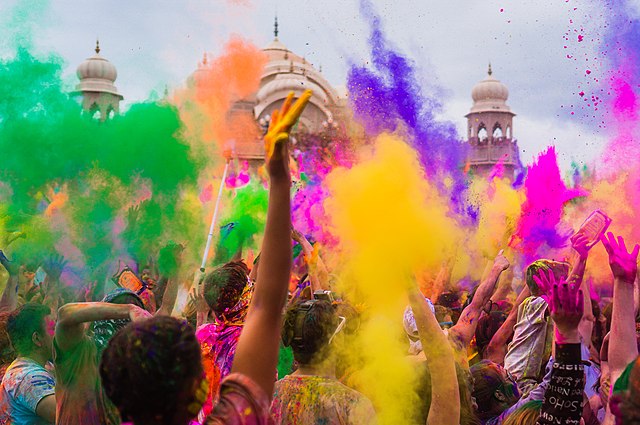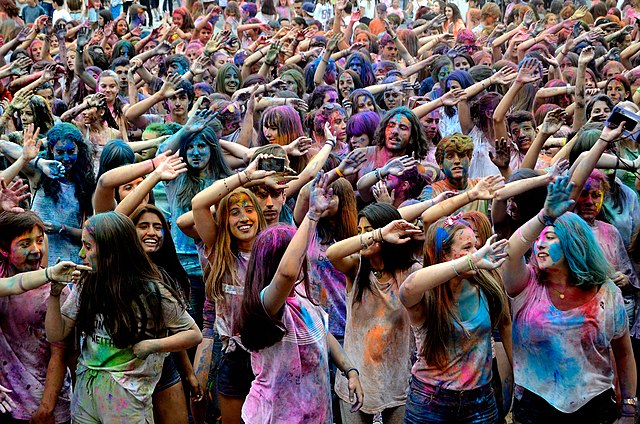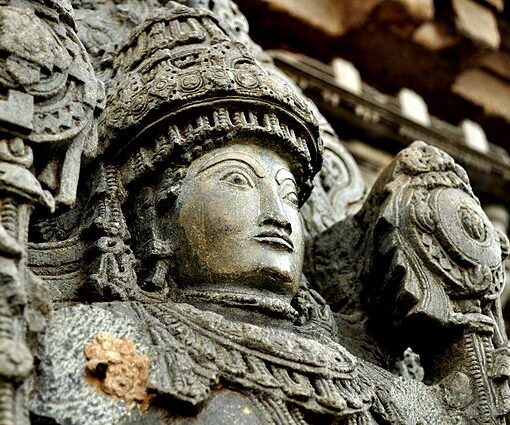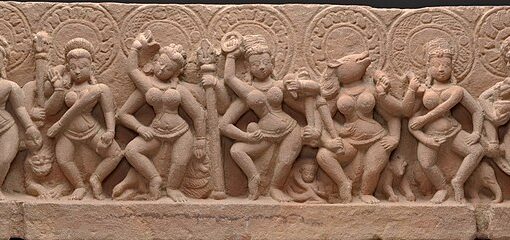Introduction to the meaning of Holi: The Hindu festival of Holi symbolizes the triumph of good over evil, the arrival of spring, and the celebration of divine love. Holi, also known as the “Festival of Colors” or the “Festival of Love”, is of great importance to Hindus, as it marks the end of winter and the beginning of a new season.
The Hindu festival of Holi is celebrated annually on the full moon day in the lunar calendar of Phalguna, corresponding to late February or early March on the Gregorian calendar.
The meaning of the Holi festival goes beyond its religious and cultural significance. It is a celebration of life, love, and joy, and promotes values such as forgiveness, unity, and harmony. It is a time for people to come together, forget their differences, and celebrate their shared humanity.
Featured Image: TAPAS KUMAR HALDER, Girl in costume of Krishna (3), CC BY-SA 4.0
You may also like:
Holi, The Happy Festival of Colors: Celebrating Love & Oneness
Table of Contents
- How is Holi Celebrated
- Holi Celebrations in India
- The Significance of Colored Powder and Water in Holi
- The Meaning of Holi Colors
- The Meaning of Holi through the Hindu Legends
- The Spiritual Meaning of Holi
- The Cultural Meaning of Holi
- The Social Meaning of Holi
- The Role of Women in Holi Celebrations
- The Global Meaning of Holi
- Final Thoughts on The Meaning of Holi
How is Holi Celebrated
The Holi festival is celebrated over two days. The first day is known as Holika Dahan or Choti Holi, and the second as Dhulandi or Rangwali Holi. On Holika Dahan a bonfire is lit to symbolize the triumph of good over evil and to ward off evil spirits. Dhulandi is a day full of fun, when people throw colored powders, spray colored water, and dance to celebrate the arrival of spring and the divine love between Radha and Krishna.
Holi Celebrations in India
The celebrations for Holi can vary depending on the region. In northern India, particularly in the state of Uttar Pradesh, the Holi festival is celebrated with great fervor and enthusiasm. The streets are filled with people dancing, singing, and throwing colors. Holi parties and events are organized everywhere, featuring DJs, live music, and entertainment.
In contrast, in southern India, the celebrations are more subdued and focus mainly on the religious aspect of the festival with people gathering in temples to perform special prayers and rituals.
The Significance of Colored Powder and Water in Holi
The use of colour powder and water is a significant aspect of the festival of Holi. The powder, known as “gulal,” is traditionally thrown on festival goers, and people dance and play with it.
In addition, people also use water balloons and water guns to douse each other in vibrant colors. However, in recent years, the use of synthetic colors and dyes, instead of the natural ingredients used in the past, has raised some environmental concerns over the celebration of Holi.
As regards the use of water in Holi celebrations it is said to symbolize the arrival of spring and the end of the dry season. Water is believed to have a purifying effect, both physically and spiritually.
The Meaning of Holi Colors

The Hindu festival of Holi is an explosion of color, but there’s a symbolic significance for Hindus behind each of the colors. Colors can convey different emotions and messages, and can be used to express identity and culture. For example, in Hinduism, the color red is often associated with love, passion and fertility, while the color saffron is associated with purity and spirituality.
The Significance of Blue Colour
The use of blue color powder, also known as “Neela”, is a way of celebrating the divine love of Lord Krishna, who had a blue complexion, and Radha. Blue is the color of the sky and ocean and it symbolizes calm and serenity. In Indian culture, blue can also symbolize immortality, bravery, and determination.
The Significance of Green Colour
Green is the color that symbolizes growth, nature and the manifestation of the divine and is associated with the Hindu god Lord Vishnu, the preserver of the universe. The use of green color powder is a way of celebrating the arrival of spring and the rejuvenation of nature and the new beginnings that come with it.
Green is believed to bring good luck and prosperity and is also associated with Devi Lakshmi, the Goddess of prosperity and wealth.
The Significance of Pink Colour
Pink is a color that is commonly associated with Holi festival celebrations, particularly among married women. It is cheerful and is associated with youth, good health and playfulness. Pink adds more fun and joy to Holi festival celebrations.
The Significance of Red Colour
Red is the color of love, passion and sensuality. It is the color of choice for weddings and various events. Brides and married women wear red to symbolize fertility, purity and love. Hindu women put a red dot or tilak on their forehead and may also apply a red sindoor in the parting of their hair as a sign of marriage.
The color red is also associated with warrior goddess Durga who symbolizes power and strength.
The Significance of Orange Colour
Orange is the most sacred color in India. In Hinduism, it symbolizes tranquillity, brightness and knowledge. Orange or Saffron Orange means purity, hence the gurus, yogis, and holy men wear saffron robes, often matched with bright saffron turbans.
Orange is one of the colors on the Indian flag. It symbolizes the strength and courage of the Indian people.
The Significance of Yellow Colour
Yellow is the color of Sunshine, Happiness, Meditation, and Peace. Many Hindu gods wear a yellow attire like Lord Vishnu, Lord Krishna, and Lord Ganesha. Yellow symbolizes joy and cheerfulness but it also represents ambitions and wisdom.
Yellow is often associated with goddess Saraswati.
The Significance of Purple Colour
In Hinduism, purple is the color of the seventh chakra (crown chakra) and is associated with spiritual awakening and divine power. In India it has always been connected to royalty, wealth, power, spirituality and wisdom.
The Significance of Black Colour
In India, the black color is associated with mystery, dark desires, evil, negativity, and inertia. It is a color that must not be used in Holi’s joyous celebrations.
The Significance of White Colour
White color symbolizes peace, truth and purity. Since, the festival of Holi is about brotherhood and spreading love, people tend to wear white clothes on this day.
The Meaning of Holi through the Hindu Legends
The Holi festival marks new beginnings and the triumph of good over evil and this is evident in the ancient Hindu legends that surround the holiday.
One such legend is the story of Lord Vishnu and his half-lion incarnation, Narasimha, who saves his devotee, Prahlada, from his evil father, Hiranyakashipu. Another legend is the story of Lord Krishna and his love for Radha, where he playfully applies color to her face to express his divine love for her.
The Spiritual Meaning of Holi
Holi is celebrated as the victory of good over evil, the arrival of spring, and the celebration of divine love. Its spiritual significance is associated with the mythological stories of Prahlada and Hiranyakashipu and the divine love of Lord Krishna and Radha.
The Holi festival has a deep spiritual significance in Hinduism since it marks a time for people to celebrate their faith, express their devotion, cleanse their soul from impurities and seek blessings from the divine.
Celebrating the Divine Love
Holi is a celebration of the divine love between Radha and Krishna, two of the most beloved deities in Hinduism. Their love story is often seen as a metaphor for the love between the individual soul and the divine, with Krishna representing the ultimate truth and Radha representing the devoted soul that seeks union with the divine.
Cleansing the Soul
During Holi people seek to cleanse their souls of impure, evil thoughts and negative energy. This is done through the ritual of Holika Dahan, which symbolizes the burning away of negative influences and the triumph of good over evil.
Seeking Forgiveness
Holi is a time when people seek forgiveness for past mistakes. They offer prayers and seek blessings from the divine, asking for forgiveness for any wrongs they may have committed.
Renewing the Spirit
The festival of Colors marks the perfect time for renewal and rejuvenation. It is the ideal time to leave the past behind and start anew, with a fresh perspective and renewed spirit.
Celebrating the Oneness of All Beings
The Hindu Festival of Colors is a joyous celebration of the oneness of all beings and the interconnectedness of all life. It is about recognizing the divine in every living being and promoting harmony and unity.
The Cultural Meaning of Holi
Holi has evolved over time to reflect changing cultural norms and practices. Its cultural significance can be gauged from the fact that its origin derives reference from various mythological tales. Without doubt, this has led to a deep faith and respect towards the celebration of the festival, as Hindus strongly believe in mythology.
The moral behind all these stories is victory of good over evil, which is a lesson for the human race. But, the tales also instill the faith of man into the ultimate power of God and divine love. Through this prism we can view the Hindu festival of Holi as the medium through which people are inspired to lead a virtuous life.
Celebrating Diversity
The Holi festival promotes unity and harmony by bringing people from different communities, castes, and backgrounds together. Holi acts as a social catalyst, promoting unity and harmony. Social barriers are broken down and people forget their differences to celebrate their shared humanity.
Promoting Forgiveness & Reconciliation
Holi is also a time for forgiveness and reconciliation, when people apologize for past wrongs, and forgive each other for any misunderstandings or conflicts. In this sense, Holi acts as a glue that bonds people together, strengthens relationships and promotes peace.
Celebrating Nature
The Festival of Colors is a celebration of nature and the coming of spring. Holi marks the time for people to celebrate the beauty and vibrancy of nature and to express their gratitude for the blessings of life.
The Social Meaning of Holi
The Hindu festival of Holi has a significant social impact in India and Nepal. It is a festival celebrated by people from all walks of life, regardless of color, caste, creed or social status.
In this sense, Holi festival and celebrations serve as a social equalizer, breaking down barriers of class, caste and gender. Holi celebrations bring the society together and strengthen the secular fabric of the country. The festival brings the nation together, as it is not just celebrated by Hindus but also by the Sikhs, Jains and Christians.
Breaking Social Barriers
Holi breaks down social barriers, bringing people together in a spirit of joy and celebration. During the festival people forget about their differences and celebrate their shared humanity, promoting social unity and harmony.
Strengthening Community Bonds
The Holi festival helps to strengthen community bonds and promote a sense of togetherness. People come together to celebrate, share food and sweets, and exchange greetings and gifts.
Promoting Reconciliation & Peace
Holi marks a time for forgiveness and reconciliation. People apologize for past wrongs and forgive each other for any misunderstandings, old grudges or conflicts and this helps to strengthen relationships and promote peace.
Encouraging Positive Social Behavior
The Holi festival is all about joy and merriment, but it is also a time when people are reminded to behave responsibly and with respect for others. Holi encourages people to practice positive social behaviors, such as kindness, generosity, and compassion.
Celebrating Cultural Diversity
Holi is celebrated across India and Nepal, and each region has its own unique way of observing the festival. This diversity is celebrated and cherished, promoting cultural exchange and understanding.
Hence, Holi is a festival that promotes social unity, harmony, forgiveness, and reconciliation. It is a time for people to come together and celebrate their shared humanity.
The Role of Women in Holi Celebrations

The Hindu festival of Holi is celebrated by people of all ages and genders, but in ancient times, married women were not allowed to participate in Holi festival celebrations.
However, over time the role of women in Holi festival celebrations has evolved and today, women of all ages and marital status not only participate but also play an important role in organizing the Holi festival celebrations.
The Global Meaning of Holi
The Holi festival of colors knows no bars or boundaries. It has become a symbol of multiculturalism and cross-cultural exchange where people come together in a spirit of brotherhood and love.
Final Thoughts on The Meaning of Holi
The meaning of Holi, the festival of colors, is multi-faceted and steeped in tradition and mythology. It is a festival that celebrates the triumph of good over evil, the arrival of spring, and the expression of divine love. It is a time for people to come together and bond, forget their differences, celebrate love and embrace new beginnings.
With its use of vibrant colors, music, and food, Holi festival is a celebration that is both fun and meaningful, making it an important and beloved festival in the Hindu culture. So, this Holi take time out to unwind and play with colours! Dance your heart out and celebrate the festival of colours, with your loved ones!
Happy Holi
होली की बधाई
Holi ki badhai






